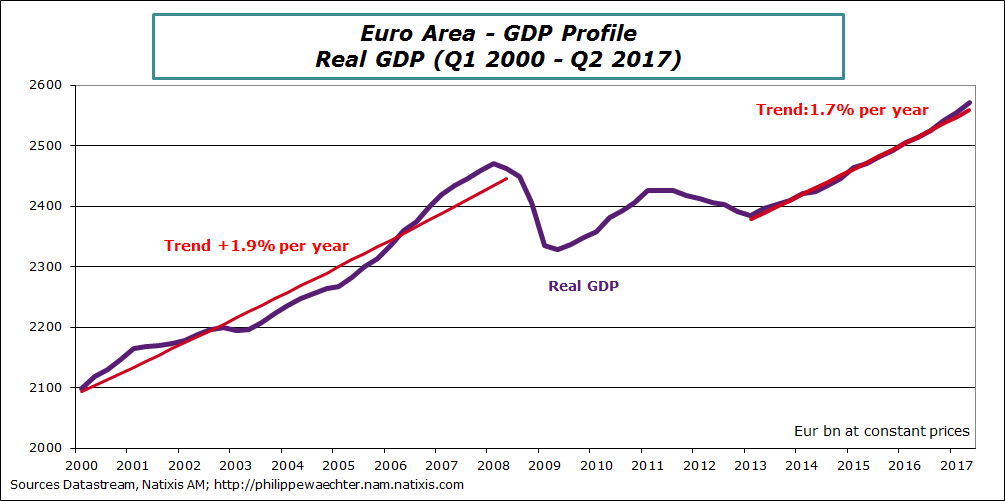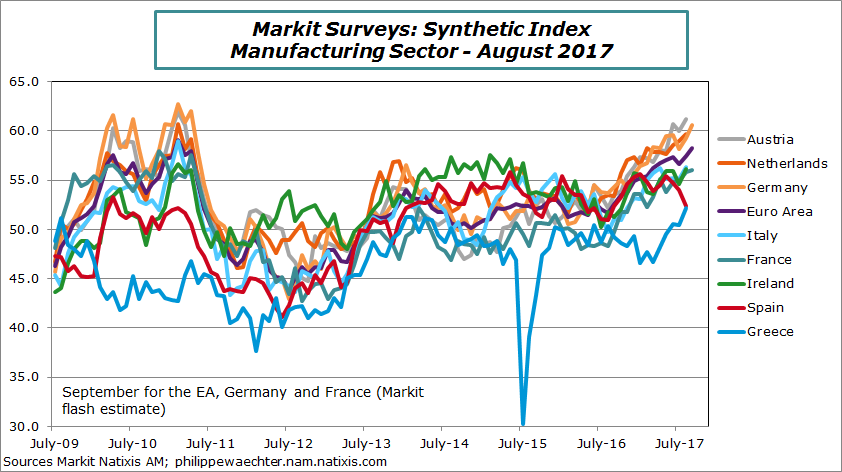The Euro Area (EA) economy is now following a robust growth trend. It has started in 2013 and in 2016 and 2017 the EA GDP growth will be higher than in the US. On the graph, on the right it can be seen that there are little fluctuations in the current growth trajectory.
This reflects a less restrictive fiscal policy at the EA level in reversal to what was seen at the beginning of the decade. Fiscal policy was too tight in 2011 to 2013 and pushed the economy into a deep and prolonged recession from mid-2011 to the end of 2012. A more neutral fiscal policy helps to improve its predictability and to reduce uncertainty for the private sector.
After summer 2012 the ECB has adopted a very accommodative monetary regime. Interest rate converged to 0% for the refi rate and after 2014 there were two operations bringing liquidity to the financial and banking sector and to financial markets. On one side there was a temporary exchange of assets (4 year period) which targeted the banking sector (LTRO). The recovery was possible only with a strong and robust banking sector. In the fall of 2017 the banking sector is stronger even in Italy where we were all worried. And there was an asset purchases operation in order to push down interest rates. The QE operation is the purchase of a large amount of sovereign debt (EUR 60bn per month since April 2017) and of corporate debt.
The ECB target is to reduce incentives for the private sector to postpone their expenditures. With very low interest rates the incentive to transfer wealth through time is low. Cash remains on banking account and people and companies spend more. This can be seen on the graph with the recovery on private demand after 2013.
The recovery is domestically oriented even it has taken advantage of a stronger external environment notably since the beginning of 2017 with the renewed growth in world trade.
Since 2014 companies and households face a neutral fiscal policy and a very accommodative monetary policy while the oil price is not expensive and the lack of inflation everywhere in the world (except Brazil and Russia) brought low interest rates easing a global recovery.
Since this date companies and households optimize their behavior subject to their own constraints and not on economic policy measures and their volatility. Therefore we assist at a catchup in employment and in corporate investment. Since the beginning of 2013 more than 6.6 million jobs have been created.
Fiscal policies are expected to remain neutral at least and Mario Draghi clearly wants to see a robust and long lasting improvement of the European situation before changing its monetary policy stance. These commitments are strong
The other point to mention is that this recovery can be seen in almost every country of the Euro Area. This can be seen on the graph which shows Markit survey for the manufacturing sector until August 2017.
Every country is above the threshold of 50, even Greece. France which was lagging Germany has now converged to the European average.
The important issue here is that Euro Area countries trade a lot one with each other. Therefore the improvement in domestic activity is a source of impulse to intra EU trade which creates a stronger momentum. Other things being equal, the current recovery will continue in 2018.
Imbalances has been reduced: the budget deficit in the Euro Area for the first quarter of 2017 was just below 1% (0.9%) and the rapid growth expected for this year (2.2% in 2017) and next year (2% in 2018) will again reduce the level of the budget deficit. I make a digression here by saying that with lower public deficits, governments will issue fewer bonds therefore the ECB will be able to reduce its asset purchases program but will still have a downside impact on interest rates. The spread between issuances and purchases will remain negative as in 2017 even if the ECB program is reduced. That’s not a tapering in the form seen in the US.
Another important reduction of imbalances is seen on current account. At the peak of the crisis, Spain, Italy and some others had large current account deficit. This is no longer the case. Nevertheless Germany and the Netherlands still have large surplus. This explains the large current account surplus of the Eurozone (almost 3% of GDP).
This means that the contagion risk of a negative shock from a country to another is now very limited. Nevertheless the counterpart of the current situation is flows of capital to Germany and still negative in Spain and Italy. But this situation reflects more what was seen a few years ago than now. In other words, financial imbalances have not been totally rebalanced.
What can we expect?
The current growth momentum is robust with a strong catch up in employment and corporate investment. This will improve income and productivity and will extend the current virtuous cycle. We expect 2.2% GDP growth this year and 2% next year. It is a little above potential growth. The main target on economic policy will be to improve this potential growth. That’s why we expect a neutral fiscal policy in order to avoid change in expectations in a period where private momentum is sufficiently strong to drive the cycle. On the monetary side we expect that the ECB will maintain its interest rates at the current very low level (0% for the refi rate and -0.4% for the deposit facility rate) until at least 2019 and that the QE will be extended to 2018. The ECB will purchase less than in 2017 with EUR 40bn each month versus 60 in 2017. If the cycle remains virtuous we can expect a reduction of this amount at mid-year and a stop at the end of 2018 or at the beginning of 2019. The ECB said it will maintain its interest rates at the current level long after the end of the QE. That’s the reason we do not expect a move before the end of 2019. Moreover the ECB inflation forecasts at 1.5% are still below the 2% target in 2019: no reason to hurry in the monetary policy normalization.
Structural reforms have been put in place in France on the labor market. The objective is to improve the labor market reaction at the beginning of the recovery. We expect more in France notably on the retirement scheme.
The exchange rate will remain high and probably higher than what is currently observed. This comes from 2 explanations: 1 – expectations on European institutions are now positive – The association of Angela Merkel and Emmanuel Macron will improve them reinforcing the positive perception that Europeans have on this institutional construction. 2 – The Euro Area is now perceived as a financial stability area as the US and UK are perceived as risky.
Until now the impact of the high euro has been negligible as the growth momentum sources are domestic. But this will change in the future. The ECB wants to smooth the transition and that’s also a reason for a very accommodative monetary policy for long.
Written on September the 19th (a graph has been updated with data published on the 23rd)
For more details on my blog you can follow the links below
On the robust economic environment
https://philippewaechter.en.nam.natixis.com/2017/08/25/video-strong-prospects-on-economic-activity-for-the-eurozone/
https://philippewaechter.en.nam.natixis.com/2017/08/16/sustained-growth-in-the-eurozone-since-the-beginning-of-the-year/
On the strong euro:
https://philippewaechter.en.nam.natixis.com/2017/09/15/video-a-strong-euro-as-a-european-revival/
On the ECB monetary policy and the ECB forecasts:
https://philippewaechter.en.nam.natixis.com/2017/09/07/the-ecb-decision/
https://philippewaechter.en.nam.natixis.com/2017/09/07/according-to-the-ecb-more-growth-in-2017-but-less-inflation-all-the-time/
On jobs and the French labor market reform
https://philippewaechter.en.nam.natixis.com/2017/09/13/euro-area-6-6-millions-jobs-since-2013/
https://philippewaechter.en.nam.natixis.com/2017/09/04/labor-law-reform-momentum-on-the-move/

Philippe Waechter's blog My french blog





